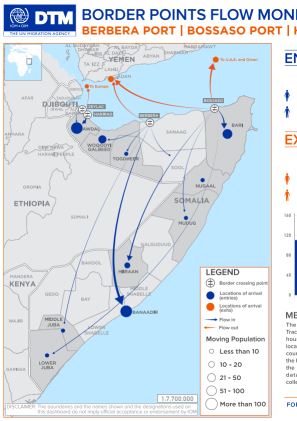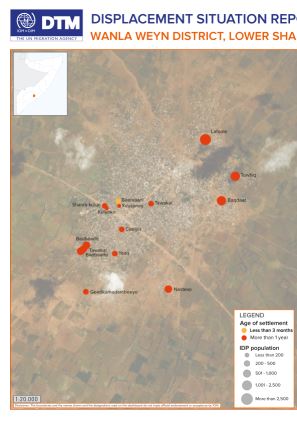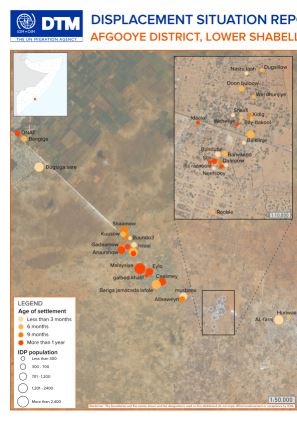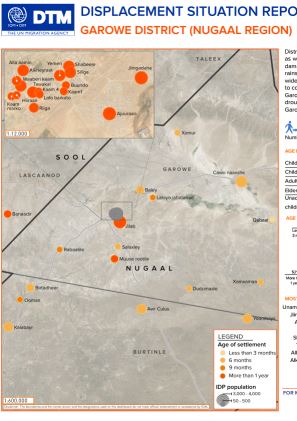-
Countries
-
Data and Analysis
-
Special Focus
-
Crisis Responses
Somalia
Somalia
Suivi des PDI
Mouvements de déplacement
3,862,000
IDMC 2023
cycle de collecte de données
À propos Somalia
IOM Somalia Displacement Tracking Matrix (DTM) aims to collect, analysis and disseminate information on displacement. DTM is IOM’s information management system to track and monitor numbers, locations, movements, needs and vulnerabilities of displaced people. The data outputs, including reports, maps, datasets and online interactive resources, support responses in humanitarian crisis, evidence-based decision making, durable solutions programming and migration research. DTM Somalia was first launch in 2016.
Since the collapse of the Somali central government in 1991, Somalia has suffered a highly complex protracted conflict characterized by changing political dynamics and power shifts. Forced displacement remains an ongoing reality for people living in Somalia due to conflict, environmental hardships, combined with inadequate resource distribution that is often exacerbated by clan-based, ideological differences and land and natural resource competition. Natural hazards, including drought and flooding, combined with widespread security threats have caused one of the world’s largest displacement crises, with 3.8 million IDPs recorded at the end of 2022. Somalia also has a strategic geographical position on the eastern route, which connects the Horn of Africa to the Gulf countries, representing one of the most dangerous and frequented migration corridors in the world.
Bailleurs de fonds
- EU
- ECHO
- BHA
- Canada
- JSB
- World Bank
Somalia — Baidoa Movement Trend Tracking Report (16—22 February 2018)
In the week of 16-22 February 2018, there were 526 new arrivals through Baidoa checkpoints and Zero Exits. This is the second week in a row with no exit.
Somalia — Dolow Movement Trend Tracking Report (22 December 2017 — 1 February 2018)
IOM began collecting data on IDP movements in and out of the two main IDP sites in Dolow: Kabasa (population: 5,500 HHs) and Qansaxlay (population: 2,900 HHs).
Somalia — Baidoa Movement Trend Tracking Report (19—25 January 2018)
During the week of 19-25 January 2018, there were 2,028 new arrivals at the Baidoa checkpoints, the highest number ever recorded. The upsurge in the numbers of new arrivals this week is due to the ongoing fighting in Abal village, Bakool region and the IDP eviction at the outskirts
Somalia — Baidoa Movement Trend Tracking Report (12—18 January 2018)
In the week of 12-18 January 2018, there were 645 new arrivals, the most recorded since the first week of November, as well as 26 exits at the Baidoa checkpoints.
Somalia — Baidoa Movement Trend Tracking Report (5—11 January 2018)
During the week of 5-11 January 2018, there were 256 new arrivals and 52 exits at the Baidoa checkpoints.
Somalia — Displacement Situation Report Somaliland (November 2017)
Over the past few years, Somaliland districts have become host to households and individuals that have been displaced as a result of conflict, insecurity or drought from all over Somaliland.
Somalia — Baidoa Movement Trend Tracking Report (29 December 2017 — 4 January 2018)
During the week of 29 December 2017 - 4 January 2018, there were 374 new arrivals and only 21 exits at the Baidoa checkpoints. This represents the fourth week in a row that the number of exits has remained below 100.
Somalia — Displacement Situation Report Gedo (September — October 2017)
As of October 2017 DTM estimates 168,000 IDPs in Gedo district, living in 310 IDP sites, the majority of IDPs considered as integrated within the host community.
Somalia — Border Point Flow Monitoring — Doolow, Elwak, Belet Xaawo (November 2017)
DTM identified 544 individual entries and 619 exits at Flow Monitoring Points in Doolow, Elwak and Belet Xaawo in November 2017. The entries represent a 36% increase between October and November while the exits decreased by 42%.
Somalia — Border Point Flow Monitoring — Diff, Dhobley, Tulo-Barwako (November 2017)
DTM identified 1,195 individual entries and 1,889 exits at Flow Monitoring Points in Diff, Dhobley and Tulo-Barwako in November 2017. The entries represent a 6% decrease between October and November while the exits increased by 4%.
Somalia — Border Point Flow Monitoring — Doolow, Elwak, Belet Xaawo (October 2017)
DTM identified 401 individual entries and 1,069 exits at Flow Monitoring Points in Doolow, Elwak and Belet Xaawo in October 2017. The entries represent a 2 times increase between September and October while the exits increased by 38%.
Somalia — Border Point Flow Monitoring — Diff, Dhobley, Tulo-Barwako (October 2017)
DTM identified 1,265 individual entries and 1,821 exits at Flow Monitoring Points in Diff, Dhobley and Tulo-Barwako in October 2017. The entries represent a 19% increase between September and October while the exits increased by 8%.
Somalia — Border Point Flow Monitoring — Berbera Port, Bossaso Port, Harirad, Zeylac (October 2017)
DTM identified 809 individual entries and 31 exits at Flow Monitoring Points in Berbera Port, Bossaso Port, Harirad and Zeylac in October 2017.
Somalia — Displacement Situation Report Modagishu, Banadir Region (October 2017)
Mogadishu hosts the largest estimated protracted internally displaced population in Somalia, mainly living in informal IDP sites across the city. DTM’s October 2017 data collection focusing on the greater Mogadishu area identified a total of 545,000 individuals in over 840 IDP sites.
Somalia — Displacement Situation Report Wanla Weyn (October 2017)
Drought and insecurity has caused many in Lower Shabelle region to flee their rural homes into more urban areas. Wanla Weyn town, as the center of Wanla Weyn district is host to over 20,000 displaced individuals, many living on the outer periphery of the town.
Somalia — Displacement Situation Report Afgooye District (October 2017)
After the outbreak of the civil war in 1991, parts of Afgooye town became a place of refuge for many of SouthernSomalia’s internally displaced people. The region has become home for many displaced persons from Lower Shabelle, with some also arriving from Bay and Hiraan.
Somalia — Displacement Dashboard 5 (June 2017)
Between 10th May and 3rd June 2017, DTM found that approximately 1.5 million people were reported to be displaced, the majority of them being children (under 18 years) and women, bringing the total population displaced to 431,634 people.
Sep 29 2017
Somalia — Displacement Dashboard 5 (June 2017)
Somalia — Displacement Situation Report Garowe District, Nugaal Region (June 2017)
Displacement is in Nugaal is centred in the main towns of Garowe and Burtinle. A majority of the IDPs originate from southern and central Somalia mostly displaced due to drought. These IDPs are often at risk of fire outbreaks and flooding, especially those living along the river bank of Garowe.
Somalia — Displacement Situation Report Eyl District, Nugaal Region (June 2017)
In order to better understand the geographic distribution of displacement sites, and population estimates, DTM rolled out the Emergency Tracking Tool (ETT).
Somalia – Border Point Flow Monitoring (June 2017)
DTM identified 59 individual entries and 1,182 exits at Flow Monitoring Points in Elwak, Doolow and Belet Xaawo in June 2017. The entries represent a 43% decrease between May and June while the exits only moderately increased by 3%.
Somalia — Displacement Situation Report Somalia (June 2017)
This displacement situation report depicts the displacement in 26 districts throughout Somalia. It is estimated that the total IDP population stands at 1.4 million people and that there are 1,549 IDP locations.
Somalia — Displacement Situation Report Somaliland (June 2017)
Hargeysa, Borama and Zeylac districts are growing urban areas in Somaliland, and over the past few years become host to households and individuals that have been displaced as a result of conflict, insecurity or drought.
Somalia — Displacement Situation Report Bari (June 2017)
Bari region in Puntland, has experienced protracted civil conflict with loss of livelihoods and widespread displacement of 229,000 IDPs.
Somalia — Displacement Situation Report Kismayo Town (June 2017)
Kismayo, the second largest city in South-central Somalia has been devastated by civil conflict, floods, famine and the


























